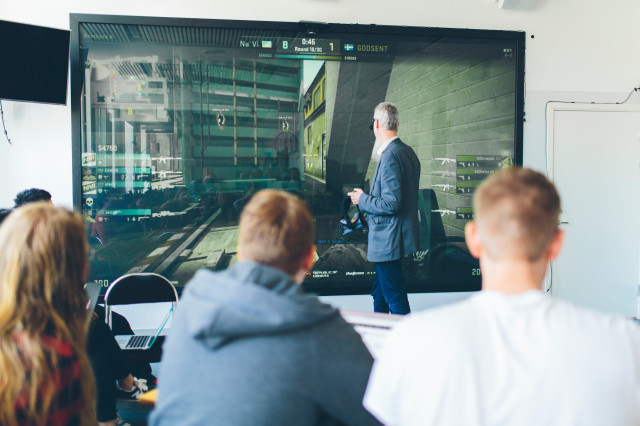- Learning of representations from raw data: images and text
- Principles of supervised learning
- Elements for different methods for deep learning: convolutional networks and recurrent networks
- Theoretical knowledge of and practical experience of training networks for deep learning including optimisation using stochastic gradient descent
- New progress in methods for deep learning
- Analysis of models and representations
- Transferred learning with representations for deep learning
- Application examples of deep learning for learning of representations and recognition
DD2424 Deep Learning in Data Science 7.5 credits

Information per course offering
Choose semester and course offering to see current information and more about the course, such as course syllabus, study period, and application information.
Information for Spring 2025 deep25 programme students
- Course location
KTH Campus
- Duration
- 17 Mar 2025 - 2 Jun 2025
- Periods
- P4 (7.5 hp)
- Pace of study
50%
- Application code
60207
- Form of study
Normal Daytime
- Language of instruction
English
- Course memo
- Course memo is not published
- Number of places
Max: 300
- Target group
Searchable for students admitted to CLGYM-TIKT or CLGYM-TIDE and following masters programmes: TMAIM, TCSCM, TSCRM, TEBSM, TIEMM, TIVNM, TMEKM
- Planned modular schedule
- [object Object]
- Schedule
- Part of programme
Master of Science in Engineering and in Education, åk 4, TEDA, Conditionally Elective
Master of Science in Engineering and in Education, åk 5, TEDA, Conditionally Elective
Master's Programme, Computer Science, åk 1, CSCS, Conditionally Elective
Master's Programme, Computer Science, åk 1, CSDA, Conditionally Elective
Master's Programme, Computer Science, åk 1, CSVG, Recommended
Master's Programme, Computer Science, åk 2, CSVG, Recommended
Master's Programme, Cybersecurity, åk 1, Recommended
Master's Programme, Cybersecurity, åk 2, Recommended
Master's Programme, Embedded Systems, åk 1, INMV, Recommended
Master's Programme, ICT Innovation, åk 1, AUSM, Recommended
Master's Programme, ICT Innovation, åk 1, AUSY, Recommended
Master's Programme, ICT Innovation, åk 1, DASC, Recommended
Master's Programme, ICT Innovation, åk 1, DASE, Recommended
Master's Programme, ICT Innovation, åk 2, DASC, Recommended
Master's Programme, ICT Innovation, åk 2, DASE, Recommended
Master's Programme, Industrial Engineering and Management, åk 1, CYPS, Conditionally Elective
Master's Programme, Industrial Engineering and Management, åk 1, MAIG, Conditionally Elective
Master's Programme, Machine Learning, åk 1, Conditionally Elective
Master's Programme, Mechatronics, åk 1, Conditionally Elective
Master's Programme, Software Engineering of Distributed Systems, åk 1, DASC, Recommended
Master's Programme, Software Engineering of Distributed Systems, åk 1, PVT, Recommended
Master's Programme, Systems, Control and Robotics, åk 1, Recommended
Master's Programme, Systems, Control and Robotics, åk 1, LDCS, Conditionally Elective
Master's Programme, Systems, Control and Robotics, åk 1, RASM, Conditionally Elective
Master's Programme, Systems, Control and Robotics, åk 2, LDCS, Conditionally Elective
Contact
Josephine Sullivan (sullivan@kth.se)
Course syllabus as PDF
Please note: all information from the Course syllabus is available on this page in an accessible format.
Course syllabus DD2424 (Autumn 2024–)Content and learning outcomes
Course contents
Intended learning outcomes
After the course, one will be able to:
- explain the basic the ideas behind learning, representation and recognition of raw data
- account for the theoretical background for the methods for deep learning that are most common in practical contexts
- identify the practical applications in different fields of data science where methods for deep learning can be efficient (with special focus on computer vision and language technology)
in order to:
- be able to solve problems connected to data representations and recognition
- be able to implement, analyse and evaluate simple systems for deep learning for automatic analysis of image and text data
- receive a broad knowledge enabling you to learn more about the area and read literature in the area
Literature and preparations
Specific prerequisites
Knowledge and skills in programming, 6 credits, equivalent to completed course DD1337/DD1310-DD1319/DD1321/DD1331/DD100N/ID1018.
Knowledge in linear algebra, 7,5 higher education credits, equivalent to completed course SF1624/SF1672/SF1684.
Knowledge in multivariable analysis, 7,5 higher education credits, equivalent to completed course SF1626/SF1674.
Knowledge in probability theory and statistics, 6 higher education credits, equivalent to completed course SF1910-SF1924/SF1935.
Knowledge in machine learning or artificial intelligence, 6 higher education credits, equivalent to completed course DD1420/DD2421 or DD2380/ID1214.
Active participation in a course offering where the final examination is not yet reported in LADOK is considered equivalent to completion of the course.
Registering for a course is counted as active participation.
The term 'final examination' encompasses both the regular examination and the first re-examination.
Equipment
Literature
Examination and completion
If the course is discontinued, students may request to be examined during the following two academic years.
Grading scale
Examination
- LAB2 - Laboratory work, 4.5 credits, grading scale: P, F
- TEN1 - Examination, 3.0 credits, grading scale: A, B, C, D, E, FX, F
Based on recommendation from KTH’s coordinator for disabilities, the examiner will decide how to adapt an examination for students with documented disability.
The examiner may apply another examination format when re-examining individual students.
The moment TEN1 is includes both oral and written examination.
By making an optional project assignment the students can improve their final grade.
Opportunity to complete the requirements via supplementary examination
Opportunity to raise an approved grade via renewed examination
Examiner
Ethical approach
- All members of a group are responsible for the group's work.
- In any assessment, every student shall honestly disclose any help received and sources used.
- In an oral assessment, every student shall be able to present and answer questions about the entire assignment and solution.
Further information
Course room in Canvas
Offered by
Main field of study
Education cycle
Add-on studies
Contact
Transitional regulations
The previous module LAB1 is replaced by LAB2.
Supplementary information
In this course, the EECS code of honor applies, see:
http://www.kth.se/en/eecs/utbildning/hederskodex